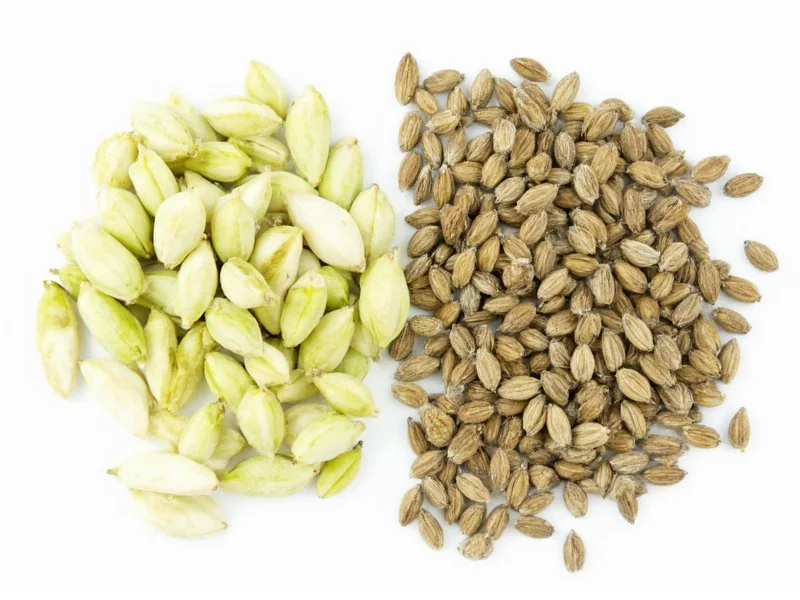Cardamom ranks among the world's most prized spices, second only to saffron in value. Yet many home cooks struggle with a fundamental question: should they use whole cardamom pods or extract the seeds? This distinction significantly impacts flavor intensity, culinary application, and storage longevity. Knowing when to use each form transforms ordinary dishes into aromatic masterpieces.
What Exactly Are Cardamom Pods?
Cardamom pods represent the complete fruit of the Elettaria cardamomum plant. These small, triangular seed capsules measure approximately 1-2 cm in length and contain 15-20 tiny black seeds. Green cardamom pods (the most common variety) display a light green hue when fresh, while black cardamom pods come from a different species (Amomum subulatum) and feature a rough, dark brown exterior.
Chefs prize whole pods for their ability to infuse dishes with a delicate, floral aroma without overwhelming other ingredients. The tough outer shell prevents the volatile oils from releasing too quickly, making pods ideal for slow cooking methods. Traditional Indian chai, Scandinavian baked goods, and Middle Eastern rice dishes often call specifically for whole pods.
Understanding Cardamom Seeds
Inside each pod lie the true flavor powerhouses—tiny black seeds with a complex citrus-pine aroma. These seeds contain the highest concentration of cardamom's essential oils, including cineole and limonene, which deliver that distinctive spicy-sweet fragrance. When recipes specify "ground cardamom," they're referring to these extracted seeds.
Freshly ground seeds provide significantly more potent flavor than pre-ground spice from stores, which often loses potency within weeks. The seeds' small size allows for even distribution in batters, doughs, and spice rubs where whole pods would be impractical. Professional bakers consistently prefer freshly ground seeds for delicate pastries where flavor precision matters.
Key Differences Between Pods and Seeds
| Characteristic | Cardamom Pods | Cardamom Seeds |
|---|---|---|
| Flavor Profile | Subtle, floral, complex with gradual release | Intense, citrusy, immediate impact |
| Culinary Applications | Slow-cooked dishes, beverages, rice, removed before serving | Baking, spice blends, marinades, sauces |
| Shelf Life | 6-12 months when stored properly | 3-6 months after grinding |
| Preparation | Crushed lightly or used whole | Must be extracted and ground |
| Potency | Milder (use 2-3 pods per 1/4 tsp ground) | Stronger (1 pod ≈ 1/8 tsp ground) |
When to Choose Pods Over Seeds (and Vice Versa)
Select whole cardamom pods when preparing dishes that benefit from gradual flavor infusion. Traditional Indian biryanis, Persian jeweled rice, and Scandinavian cardamom buns typically specify pods because they impart flavor without creating gritty texture. The pods' tough exterior prevents seeds from scattering while allowing aromatic compounds to slowly permeate the dish.
Opt for freshly ground seeds when making baked goods like Finnish pulla, Indian kheer, or Middle Eastern ma'amoul cookies. The fine powder integrates seamlessly into doughs and batters, delivering consistent flavor throughout. Ground seeds also work better in spice blends like garam masala or in creamy sauces where whole pods would create unpleasant texture.
Many professional chefs employ a hybrid approach: they lightly crush pods to release some seeds while retaining the pod structure for slow cooking. This technique combines the best qualities of both forms—immediate seed flavor with sustained pod infusion.
Proper Storage Techniques for Maximum Freshness
Preserving cardamom's volatile oils requires careful storage. Keep whole pods in airtight glass containers away from light and heat. Properly stored, they maintain peak flavor for 6-12 months. Avoid plastic containers, which can absorb cardamom's essential oils and diminish potency.
Once you've extracted seeds, grind them immediately before use for optimal flavor. If you must store ground cardamom, use an opaque container in the freezer—this extends shelf life to 3-6 months compared to 1-2 months at room temperature. Never buy pre-ground cardamom unless you'll use it within weeks; the flavor degrades rapidly after grinding.
Common Cardamom Mistakes to Avoid
Many cooks unknowingly compromise cardamom's flavor through improper handling. Toasting whole pods before use releases more flavor compounds—simply dry-fry them in a pan for 30-60 seconds until fragrant. Never skip this step for maximum aroma.
When substituting between forms, remember that 10-12 pods equal approximately 1½ teaspoons of seeds. Using too many seeds creates overpowering bitterness, while insufficient pods yield barely perceptible flavor. For the most accurate measurements, weigh your cardamom—10 pods typically weigh 1 gram.
Avoid using old cardamom that's lost its aroma. Fresh pods should feel slightly springy and release fragrance when squeezed. Stale cardamom lacks the characteristic citrus-pine scent and produces flat, one-dimensional flavor in dishes.
Practical Application Tips
For perfect cardamom extraction, place pods between two spoons and gently crush to release seeds. This technique preserves seed integrity while separating them from fibrous pod material. When using whole pods in liquid-based dishes, add them early in the cooking process to allow sufficient time for flavor infusion.
In baking applications where texture matters, always remove pods before serving. Nothing ruins a delicate dessert like biting into a tough pod fragment. For beverages like chai, steep pods for 5-7 minutes then strain thoroughly before serving.











 浙公网安备
33010002000092号
浙公网安备
33010002000092号 浙B2-20120091-4
浙B2-20120091-4